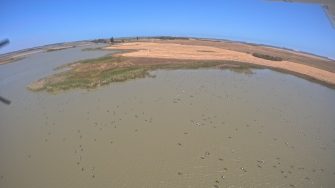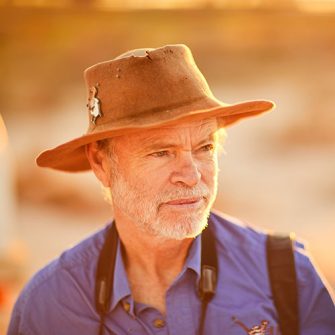
Date: Wednesday November 1st 2023
Project: Eastern Australian Waterbird Survey
Observers: Richard Kingsford (UNSW), John Porter (NSW DPE)
Trainees: Shelley Thompson (MDBA), Simon Toop (Vic GMA), Karl Hillyard & Allira Taylor-Wilkins (SA DEW), Ashwin Rudder
Pilot: Thomas Clark
This was a spectacular day on an amazing system of wetlands with tens of thousands of waterbirds. And we even lucked out with very little wind until late in the afternoon. We had on board a full complement of trainees, building up our expertise and capacity by involving State and Commonwealth people.
First part of the survey was down past the Murray Mouth
There were already small flocks of 20 to 50 Grey Teal, terns and pelicans right at the start of the survey. We passed the Murray Mouth, where the dredge is parked to keep the river’s opening to the sea.
It was then onto the North and South Coorong. Teal were there in their tens of thousand. There were also large numbers of Black Swans, Australian Shelduck, and all the cormorant species. But there were also many other waterbirds in small numbers. It was very diverse. These included Great Crested Grebes, Musk Ducks, White-faced Herons, and various tern species.
Surveying the Coorong with its high diversity and numbers of waterbirds
There were also migratory shorebirds and small flocks of banded stilts in the South Coorong. The numbers and diversity were impressive and kept us counting flat out for much of the four hours it took us to do the 120 kilometres down to the bottom and back. There were not as many as we had counted at the height of the Millennium Drought but certainly more than we have seen for a few years.
There was also the usual pelican breeding group in the South Coorong. It was much bigger than it has been for some time, with pelicans spread right across the island at various stages from sitting on eggs to chicks that were creching.
Some of the pelican breeding, extending right across the island in the South Coorong
Surveying the pelican breeding
There was also a Silver Gull breeding group and a couple of tern breeding groups.
One of the groups of terns breeding
After we'd refuelled and had something to eat, we then did the second count on Lake Alexandrina and Lake Albert.
Surveying Lake Alexandrina
We already knew that there were lots of fish-eating birds, including cormorants and pelicans. Unlike on the Coorong, we had a bit more time to point out the finer identification details of counting waterbirds to our trainees, as we went. There wasn't such a rapid fire of hundreds and sometimes thousands of waterbirds coming at us, as on the Coorong where it had been very difficult to draw breath.
Surveying large numbers of pelicans and cormorants on the freshwater lakes
Surveying one of the hundreds of flocks of pelicans and cormorants
Many of the cormorants congregate on the barrages where water leaves the freshwater lakes and flows into the Coorong. This attracts the fish and of course the cormorants.
Surveying the concentrations of cormorants along the barrages or dams that separate freshwater in the lakes from the salty water in the Coorong
Large concentrations of Great Cormorants
Lake Alexandrina nearly always has a very impressive breeding group of cormorants on an island, mostly Pied Cormorants but also Great Cormorants. Straw-necked Ibis also often breed among the cormorants. Today was no different.
Large breeding group of cormorants on an island in Lake Alexandrina
Surveying the thousands of cormorants breeding on an island in Lake Alexandrina
Lake Albert also had two breeding concentrations of Straw-necked Ibis of a few hundred. There were also another four or five breeding concentrations on Lake Alexandrina. They use the reedbeds and preferably on islands. Australian White Ibis also breed among these concentrations but always in lower numbers.
One of the concentrations of breeding Straw-necked Ibis on Lake Alexandrina
There were also one or two groups of breeding Royal Spoonbills.
It was also good to see so many Australian Shelduck on both the Coorong and the Lower Lakes. They were in the thousands for the first time for a while.
Flying over a flock of the many Australian Shelduck

